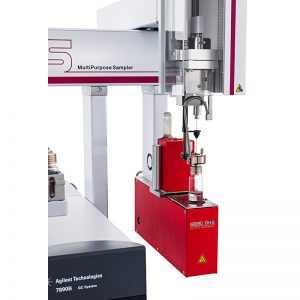A method for the determination of trace amounts of off-flavor compounds such as 2-methyl isoborneol (MIB), geosmin and 2,4,6-trichloroanisole (TCA) in drinking water is described based on dynamic headspace coupled to selectable onedimensional or two-dimensional gas chromatography – mass spectrometry with simultaneous olfactory detection (DHS1D/2D GC-O/MS). Automated DHS using a Tenax TA packed tube as trap was performed on a 10 mL-sample containing 30 % NaCl at 80ºC, and followed by thermal desorption of the trap. Combining heart-cutting with fast temperature programming (100ºC/min) of the second column resulted in improvements in both separation and analyte limits of determination due to decreased background signal of the monitored mass ion and the increased analyte peak height. Compared to DHS-1D GC-O/MS analysis, signal-to-noise ratios (S/N) were improved by a factor of 12 for MIB, 9 for geosmin, and 3 for TCA. The method showed good linearity over the concentration range from 1 to 100 ng/L with correlation coeffi cients (r2) greater than 0.9942. The limits of detection (LODs) for these compounds ranged from 0.15 to 0.22 ng/L. Simultaneous olfactory- and MS detection was succesfully performed for the lowest level sample spiked at 1 ng/L.
- Home
- About Us
- Products
- Automated Sample Preparation
- Advanced Analysis Technique
- Ion Chromatography
- Particle Size & Shape
- Zeta Potential Analyzer
- Surface Chemistry
- Spectroscopy
- Powder Characteristic
- Stability
- Elemental Analyzer – Combustion
- Ultrapure Water System
- Centrifuge
- Washer Disinfectors & Cleaners
- Microwave Digestion System
- 3D Electronic Printing
- LabAlliance Instruments
- Services
- Application
- Contact Us
- Home
- About Us
- Products
- Automated Sample Preparation
- Advanced Analysis Technique
- Ion Chromatography
- Particle Size & Shape
- Zeta Potential Analyzer
- Surface Chemistry
- Spectroscopy
- Powder Characteristic
- Stability
- Elemental Analyzer – Combustion
- Ultrapure Water System
- Centrifuge
- Washer Disinfectors & Cleaners
- Microwave Digestion System
- 3D Electronic Printing
- LabAlliance Instruments
- Services
- Application
- Contact Us
Determination of 2-Methylisoborneol, Geosmin and 2,4,6-Trichloroanisole in Drinking Water by Dynamic Headspace Coupled to Selectable 1D/2D GC-MS with Simultaneus Olfactory Detection
You are here:
- Home
- Lab Application
- Determination of 2-Methylisoborneol, Geosmin and…





